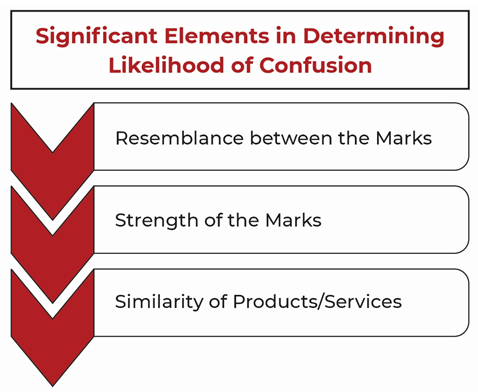Likelihood of Confusion in Trademark Applications: Things You Must Know
Every trademark application filed with the U.S. Patent and Trademark Office (USPTO) undergoes rigorous examination before being granted. While the applicants take all possible measures to ensure compliance with the trademark rules, there can be a few misses that might lead to rejection of an application. One of the most common reasons among these is the likelihood of confusion that occurs between the newly filed trademark and an earlier registered mark or a pending mark application with a prior filing date.
The following article discusses everything that applicants need to know about likelihood of confusion.
Table of Contents
Defining Likelihood of Confusion
The term “likelihood of confusion” can be defined as the confusion that exists when two trademarks are extremely similar. Further, the goods and/or services for which these marks are employed are also so closely related, that the customers can erroneously believe them to arise from the same source.
There are no stringent mechanical tests for determining the likelihood of confusion, and every mark application is decided on its own facts.
Renowned Cases of Likelihood of Confusion
- Magnavox (electrical and sound equipment) vs. Multivox (musical instruments)
- Hpnotiq (liqueur) vs. Hopnotic (beer)
- Mr. Clean vs. Mr. Rust vs. Mr. Stain (all cleaning products)
- Canya (soft drinks) vs. Cana (frozen fruit and vegetable juices)
- Seycos (watches) vs. Seiko (watches and clocks)
Critical Factors in Determining the Likelihood of Confusion
Three critical aspects decide whether the likelihood of confusion exists. These are explained in detail below:

Similarity of the Marks: The similarity of marks in terms of their general appearance, sound, connotation, and business impression is a key factor in the likelihood of confusion. The more similar the brands are, the more likely it is that they will cause confusion.
Strength of the Marks: A mark can either be strong or weak. While the former has swift public recognition, the latter is not easily recognizable in the market. One can examine the strength of these marks to ascertain whether they can lead to confusion.
Similarity of Products & Services: The products/services associated with the brands also play a key role in determining the likelihood of confusion.In casethe goods and services associated with the mark are similar, then there is a greater likelihood that buyers might be confused.
Main Reasons for Likelihood of Confusion

1. Related Goods or Services – One reason for the likelihood of confusion is the relatedness of goods and services. For instance, an applicant applies for a unique trademark for jewelry in class 14 under the Nice Classification (NCL) but the Trademark Registration already contains that iconic trademark for bangles in class 14. In this case, the marks are identical and the goods are similar. Consequently, consumers might assume that both bangles and jewelry come from the same company.
Example:
| Goods/Services Associated with Your Mark | Goods/Services Associated with Conflicting Mark |
| Make-up Powder | Lipsticks |
| Soap, Oil, and Perfume | Online Retail Store Services Featuring Cosmetics |
| Legal Process Serving | Legal Research |
2. Similarity in Sound – Similarity in sound refers to the phonetic match between marks. This means that although the marks are spelled differently, they sound alike. For example, “Mucca” might be confused with Mukka or Mucc@, two marks that are already registered for similar goods.
Example:

3. Similarity in Appearance of Text – Other than being similar in sound, trademarks can also be confusingly similar when it comes to the appearance of their text. For instance, the trademark “FLITE”, written in a bold font can be confusingly similar with another trademark “FLITE”, which has the same spelling but an Italics font.
Example:

4. Similarity in Meaning – Yet another reason for likelihood of confusion is the similarity in the meanings of two marks. For example, SEMPRE vs. ALWAYS. These marks are similar because the English translation of the Italian word “SEMPRE” is “Always”. This similarity in meaning can confuse the consumers.

“HALDI” is a Hindi word and the English translation of “HALDI” is “TURMERIC”.
5. Similarity in Design Marks – The likelihood of confusion between design marks is determined based on the similarity of their visual representation. All design marks are covered under the Vienna classifications. So, if two design marks are similar to each other under the Vienna classifications, then there can be a likelihood of confusion.
Conclusion
The USPTO conducts exhaustive searches for identifying conflicting marks while examining the mark applications. In case the office finds a similarity between a newly filed mark and an existing mark, it rejects the application – citing “likelihood of confusion”. This can happen even after the applicant’s thorough mark search before filing. Therefore, the USPTO must conduct its own search and make its own assessment of “likelihood of confusion” as part of the overall examination of mark applications.
If you are a business that intends to register a trademark, getting assistance from experts is crucial. Sagacious IP’s Trademark Search serviceaims to give clients the insights they need prior to trademark filing. Our mark searches enable businesses to save cost and time while filing marks by allowing them to evade any form of infringement or rejection.
- Kritika Rai (Trademark) and the Editorial Team
Having Queries? Contact Us Now!
"*" indicates required fields




